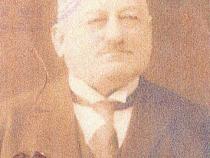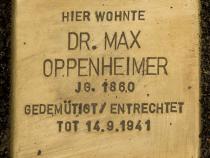Location
Breite Straße 29 b
Historical name
Breite Straße 31
District
Pankow
Stone was laid
07 August 2014
Born
22 December 1860 in Berlin
Occupation
Bankier (Privatier)
Dead
14 September 1941 in Berlin
Max Oppenheimer was born on 22 December 1860 in Berlin. His father was the merchant and leather dealer Moritz Oppenheimer (1821-1897); his mother was Eva Oppenheimer, née Jacobi (1822-1901). Moritz and Eva Oppenheimer’s last place of residence was at Möckernstraße 65.
Max attended the grammar school Friedrichwerdersche Gymnasium and enrolled to study at Berlin’s Friedrich Wilhelm University in 1885. In April 1888, he moved to Heidelberg, where he studied English and French Literature, History and National Economy at the faculty of arts until May 1892. His course record book contains the following note from 1890: “For the purpose of registering for a PhD”. In the same year, Max Oppenheimer co-founded one of the first Jewish student fraternities in Heidelberg, “Badenia”. In the fraternity’s semester report of 1895, he heads the list of those named as the “old fellows”: Dr. phil. Max Oppenheimer, Berlin, Krausnickstraße 17 (followed in second place by Dr. Magnus Hirschfeld, who was later to rise to prominence as a pioneering sexologist).
Dr. phil. Max Oppenheimer is first listed in the Berlin directory as resident at the address “Krausnickstraße 17” in 1896; a “Max Oppenheimer banking business” appears located at Unter den Linden 62/63 in 1898, at his parents’ house at Möckernstraße 65 in 1900, and at Neue Bayreutherstraße 7 in 1907. Later he seems to have retired from banking and invested his fortune in real estate, including large residential properties in Schöneberg (Feurigstraße 55 and Ebersstraße 11) and Weißensee (Streustraße 74). He was registered as the owner of these in 1905 and 1908, respectively.
In 1906 Max Oppenheimer bought a villa at Breite Straße 31 in Pankow. He and his wife Therese (born on 18 April 1881 in Berlin, the daughter of the Jewish art dealer Karfunkel; their date of marriage is not known) and their only daughter Eva (born in April 1902) moved into the first-floor apartment. The ground floor was occupied by the violinist Ernst Böhmert, whose conservatory was the site of several outstanding concerts.
Ever since his student days in Heidelberg, Max Oppenheimer had been an adherent of Jewish nationalism and the Zionist movement in Germany. In 1894, he and Max Bodenheimer co-founded the Jewish humanitarianism society (Jüdische Humanitätsgesellschaft) in Berlin, from which the Jewish students’ association (Vereinigung jüdischer Studierender) evolved. In a letter to Oppenheimer’s daughter after his death, Artur Hantke, who like Bodenheimer was a close associate of Theodor Herzl, wrote: “At least 48 years have passed since I met your father, and we worked together quite modestly at the beginning, almost without hope, when the Zionist movement started. Your father was the more advanced in years among us; for this reason, we learned a lot from him, and profited greatly from it.”
Eva Oppenheimer obviously shared her father’s convictions. She joined the Zionist youth league (“Blau-Weiß”) and emigrated to Palestine when she was only 20 years old. There she met and married Walter Grünberger, also from Germany, in 1928. With him and their eldest daughter Yachida, she returned to Germany in 1930 to campaign for German-Jewish emigration to Palestine on behalf of the Jewish Agency. The young family lived with the child’s grandparents in Pankow. On 28 December 1931, Eva’s and Walter’s son Amnon Menachem Grünberger was born. In August 1933, the family returned to Palestine. Eva and Walter gave up their German names and were now known as Chava and Yehuda Carmi. In 1935, Max and Therese Oppenheimer visited them in Haifa but did not stay. Emigration from Germany was not an option for Max Oppenheim; he hoped to “survive Hitler”.
In early 1936 Max Oppenheimer was forced to vacate and sell the house at Breite Straße well below value to the municipal savings bank Berliner Sparkasse. It was torn down the same year and new premises for the savings bank built (which were destroyed in a bomb raid in 1944). Max and Therese Oppenheimer went to live in Tiergarten (Großadmiral-von-Koester-Ufer 67a, now Schöneberger Ufer 67a) with Therese’s sister, where they were confined to two rooms. Dr. Max Oppenheimer died here on 5 December 1941, after he had been forced to also alienate his properties in Weißensee and Schöneberg. He was buried in the Jewish cemetery in Weißensee.
His wife was driven out of the apartment in Tiergarten and made to share a room with several others in a “Jew house” at Ludendorffstraße 97 (now Pohlstraße, site of the furniture store Möbelhaus Hübner). She was taken from here on 3 October 1942 and deported to Theresienstadt, where she died on 2 July 1944.
Max attended the grammar school Friedrichwerdersche Gymnasium and enrolled to study at Berlin’s Friedrich Wilhelm University in 1885. In April 1888, he moved to Heidelberg, where he studied English and French Literature, History and National Economy at the faculty of arts until May 1892. His course record book contains the following note from 1890: “For the purpose of registering for a PhD”. In the same year, Max Oppenheimer co-founded one of the first Jewish student fraternities in Heidelberg, “Badenia”. In the fraternity’s semester report of 1895, he heads the list of those named as the “old fellows”: Dr. phil. Max Oppenheimer, Berlin, Krausnickstraße 17 (followed in second place by Dr. Magnus Hirschfeld, who was later to rise to prominence as a pioneering sexologist).
Dr. phil. Max Oppenheimer is first listed in the Berlin directory as resident at the address “Krausnickstraße 17” in 1896; a “Max Oppenheimer banking business” appears located at Unter den Linden 62/63 in 1898, at his parents’ house at Möckernstraße 65 in 1900, and at Neue Bayreutherstraße 7 in 1907. Later he seems to have retired from banking and invested his fortune in real estate, including large residential properties in Schöneberg (Feurigstraße 55 and Ebersstraße 11) and Weißensee (Streustraße 74). He was registered as the owner of these in 1905 and 1908, respectively.
In 1906 Max Oppenheimer bought a villa at Breite Straße 31 in Pankow. He and his wife Therese (born on 18 April 1881 in Berlin, the daughter of the Jewish art dealer Karfunkel; their date of marriage is not known) and their only daughter Eva (born in April 1902) moved into the first-floor apartment. The ground floor was occupied by the violinist Ernst Böhmert, whose conservatory was the site of several outstanding concerts.
Ever since his student days in Heidelberg, Max Oppenheimer had been an adherent of Jewish nationalism and the Zionist movement in Germany. In 1894, he and Max Bodenheimer co-founded the Jewish humanitarianism society (Jüdische Humanitätsgesellschaft) in Berlin, from which the Jewish students’ association (Vereinigung jüdischer Studierender) evolved. In a letter to Oppenheimer’s daughter after his death, Artur Hantke, who like Bodenheimer was a close associate of Theodor Herzl, wrote: “At least 48 years have passed since I met your father, and we worked together quite modestly at the beginning, almost without hope, when the Zionist movement started. Your father was the more advanced in years among us; for this reason, we learned a lot from him, and profited greatly from it.”
Eva Oppenheimer obviously shared her father’s convictions. She joined the Zionist youth league (“Blau-Weiß”) and emigrated to Palestine when she was only 20 years old. There she met and married Walter Grünberger, also from Germany, in 1928. With him and their eldest daughter Yachida, she returned to Germany in 1930 to campaign for German-Jewish emigration to Palestine on behalf of the Jewish Agency. The young family lived with the child’s grandparents in Pankow. On 28 December 1931, Eva’s and Walter’s son Amnon Menachem Grünberger was born. In August 1933, the family returned to Palestine. Eva and Walter gave up their German names and were now known as Chava and Yehuda Carmi. In 1935, Max and Therese Oppenheimer visited them in Haifa but did not stay. Emigration from Germany was not an option for Max Oppenheim; he hoped to “survive Hitler”.
In early 1936 Max Oppenheimer was forced to vacate and sell the house at Breite Straße well below value to the municipal savings bank Berliner Sparkasse. It was torn down the same year and new premises for the savings bank built (which were destroyed in a bomb raid in 1944). Max and Therese Oppenheimer went to live in Tiergarten (Großadmiral-von-Koester-Ufer 67a, now Schöneberger Ufer 67a) with Therese’s sister, where they were confined to two rooms. Dr. Max Oppenheimer died here on 5 December 1941, after he had been forced to also alienate his properties in Weißensee and Schöneberg. He was buried in the Jewish cemetery in Weißensee.
His wife was driven out of the apartment in Tiergarten and made to share a room with several others in a “Jew house” at Ludendorffstraße 97 (now Pohlstraße, site of the furniture store Möbelhaus Hübner). She was taken from here on 3 October 1942 and deported to Theresienstadt, where she died on 2 July 1944.




